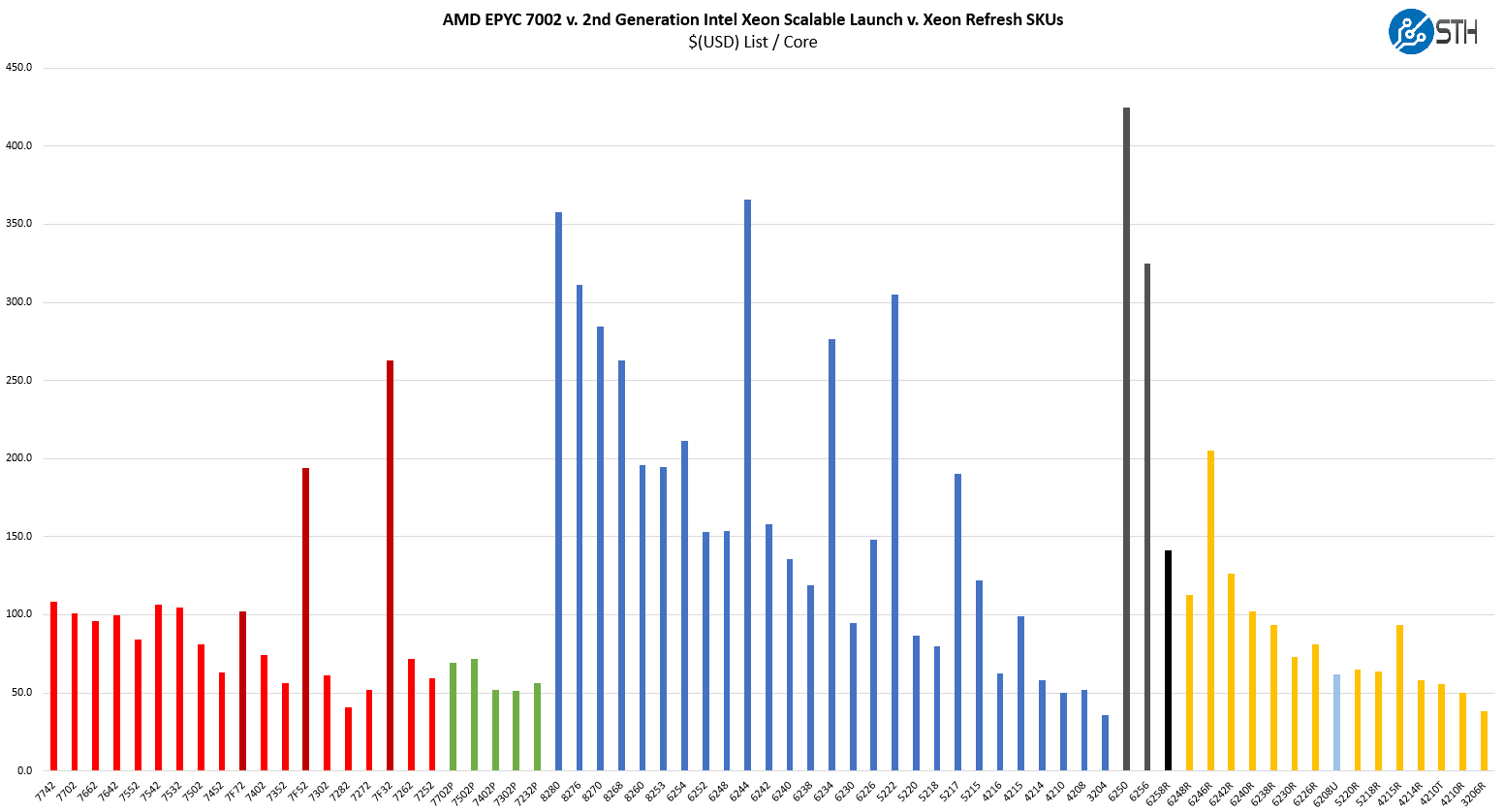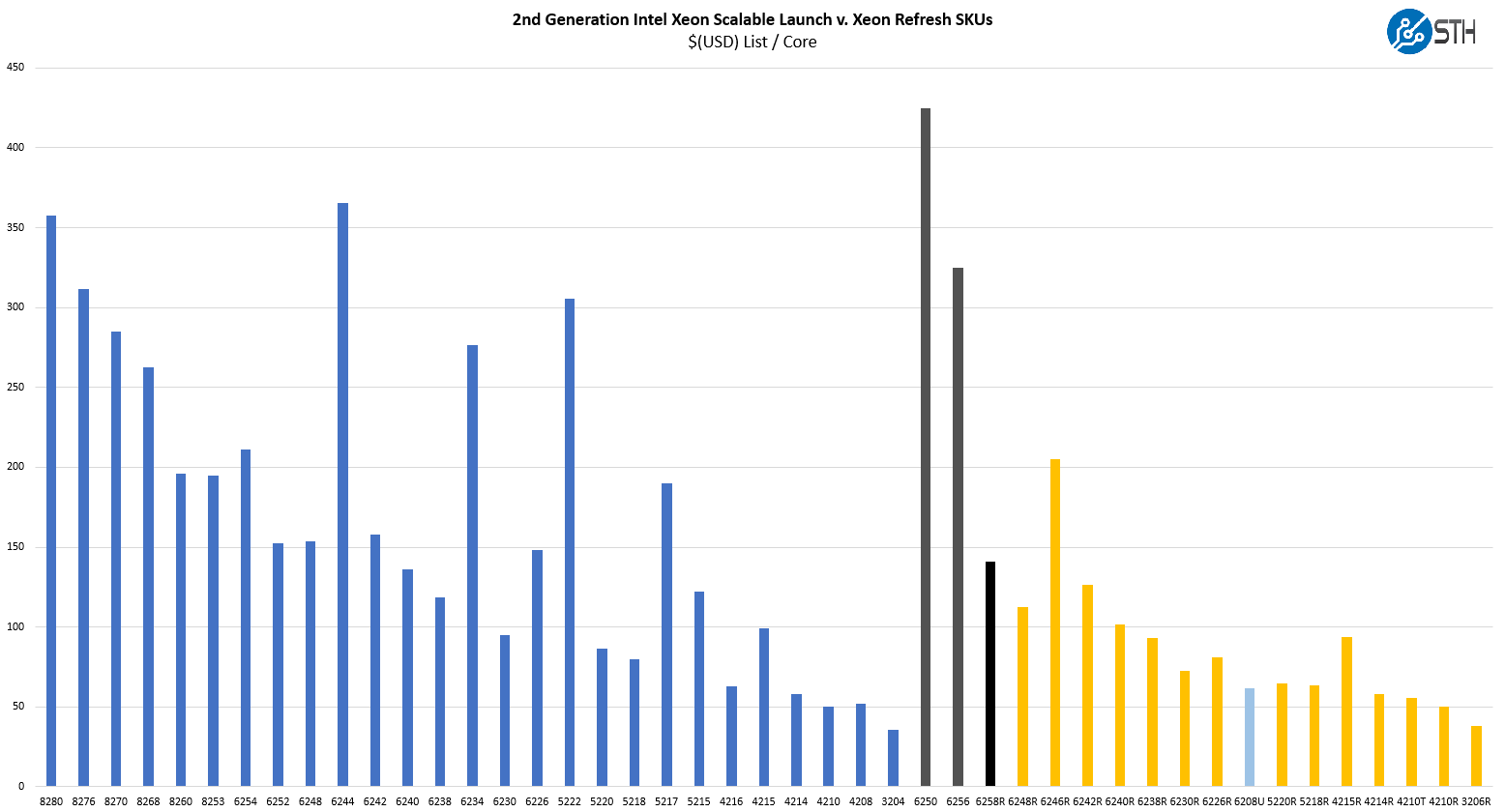Intel Xeon Gold 6258R Market Positioning
Thes chips are not released in a vacuum instead, they have competition on both the Intel and AMD sides. When you purchase a server and select a CPU, it is important to see the value of a platform versus its competitors. We are going to first discuss Intel v. AMD competition then look to Intel Xeon v. Intel Xeon.
Intel Xeon Gold 6258R v. AMD EPYC
With the addition of the Frequency Optimized EPYC parts, as well as some of the new Intel Xeon frequency optimized parts, this chart has changed drastically. Here we have the main segments of the AMD EPYC and 2nd Generation Intel Xeon Scalable processors on a $(USD) List per core basis:

The Xeon Gold 6258R is under $141/ core whereas the mainstream AMD EPYC 7002 parts are all under $109/ core list price. Intel is still commanding a premium on its 28 core part which is partially due to its higher clock speeds.
AMD offers a larger memory footprint with up to 4TB in 8-channel DDR4-3200 versus 1TB in 6-channel DDR4-2933. AMD has more PCIe I/O with 64, 96, or 128 PCIe Gen4 lanes per socket compared to Intel’s 48x PCIe Gen3 lanes. Intel has features such as AVX-512 and VNNI instructions (DL Boost) that AMD does not have but are new for 2nd Generation Intel Xeon Scalable. Perhaps the biggest feature Intel has is Optane DCPMM support. We should note here that DCPMM support is limited by memory capacity since the Gold 6258R is not an “L” SKU. Still, if one wants fast storage, DCPMM is a significant option that AMD does not have. If you are not using small DCPMM footprints, nor the new instructions, then AMD is extremely competitive.
We think this is the right pricing direction for Intel, even at the top-end of the stack. Still, Intel has the less scalable Xeon Scalable Refresh part that is at a severe core and platform disadvantage. One will note we included neither the AMD EPYC 7H12 nor EPYC 7742 results in this article. List price of a CPU is interesting, but the ability to consolidate two servers to one using higher core count 64-core EPYC parts offers a completely different competitive angle to the TCO calculations.
Intel Xeon Gold 6258R v. Intel Xeon
Intel made a strong competitive move in early 2020 with the Big 2nd Gen Intel Xeon Scalable Refresh altering the competitive landscape. Intel effectively dropped prices across most of its mainstream CPUs.
The challenge here is defining the Intel competition even with the Xeon Refresh. Intel still has a maximum of 28 cores per socket, which carried over to the 3rd Generation Intel Xeon Scalable Cooper Lake generation. Still, we can clearly see just how much lower the list price is of the cores in the refresh generation, even at the level of the Gold 6258R which is the highest core count and second-highest $/core CPU in the new line:

That means pricing of the Gold 6258R on a cost per core basis is around that of a midrange pre-refresh Xeon Gold while offering the performance of a top-end Xeon Platinum.
On the Intel Xeon Platinum 8280 side for dual-socket servers, the question effectively becomes whether the additional UPI link, in supporting servers (many servers are 2x UPI link only), is worth a significantly higher list price. It also means that if you can use the third UPI link, Intel has margin room to discount on deals to make the Platinum 8280 viable especially in the hyper-converged space where there can be a lot of socket-to-socket communication due to virtualization, NVMe storage, and network traffic.
The Intel Xeon Gold 6258R does not have 4P and 8P capabilities like the Platinum 8280, but that is now the domain of Cooper Lake. Intel re-bifurcated the Xeon line into 1P/2P and 4P/8P parts as we covered in the 2021 Intel Ice Pickle How 2021 Will be Crunch Time piece.

Given pricing and segmentation, we do not see the Gold 6258R and Cooper Lake SKUs competing on many deals.
Final Words
Intel needed the Xeon Gold 6258R. In the market, the Xeon Platinum 8280 at $10,009 list price has become a veritable punching-bag for not just AMD, but Arm server vendors as well. The high list price meant for discounting made it an easy target in the industry. With the Xeon Gold 6258R, Intel scales back the common cost/ performance claims of its competitors by almost two thirds.
While the Intel Xeon Gold 6258R offers a lot of performance in the 28-32 core processor segment, there is more than raw performance. It cannot effectively use 512GB PMem 100 modules due to a 1TB memory limit. It has six-channel DDR4-2933 memory in a market of eight-channel DDR4-3200 offerings. It has PCIe Gen3 when its competition has been shipping PCIe Gen4 for some time.
For Intel, and its customers, the Xeon Gold 6258R is a great option to remain on Intel and in the same servers that launched with Skylake in 2017. Effectively, this is the “play it safe for a discount” SKU. In the data center market with longer product cycles, that resonates with a huge segment of the market. Intel needed a part like this in its portfolio and we can thank increased competition for this.




Do you by any chance have the SPECrate2017_fp numbers for this stable of CPUs which you could post or add to article? (and maybe the EPYC 7742 too?)
Would be curious what real-world numbers you get vs. tuned vendor stats. In particular with/without AVX512.
Awesome article – Thanks!